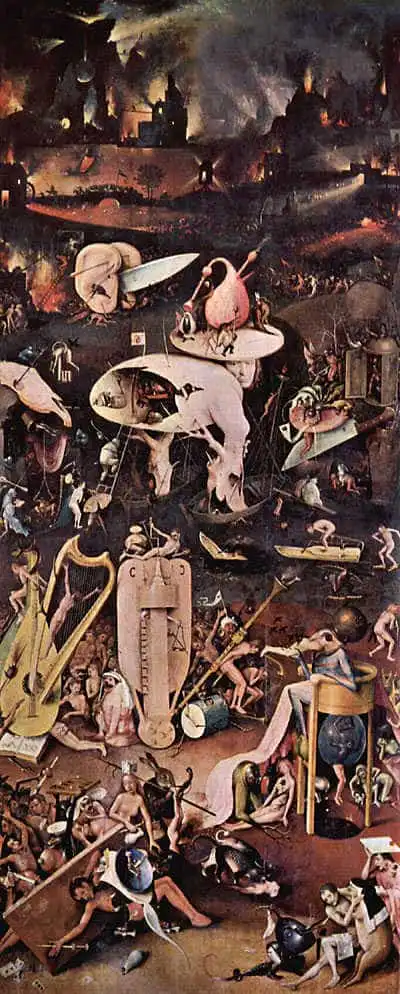FUNDAMENTALS |
BELIEFS A — Z |
|
INSPIRATION |
ENCYCLOPEDIA |
|
Hell Hell, by Hieronymus Bosch (1450-1516). Life Energy FundamentalsAn incorporeal and eternal existence may seem ideal. No worries about survival, no pain, no frustrations of bodily weaknesses. Yet, many ancient belief systems imagined the dead to enter a terrible existence, a subterranean world of darkness, cold, and tremendous anguish. A hellish world. This is the case in ancient Egyptian religion, which is why the pharaohs were so elaborate about their graves, lavishly equipped to spare them some of the ordeals of death. It is also clearly depicted in Gilgamish (see the image), the Sumerian epic that is the oldest written text we have, from about 2000 BC. Similar ideas of a dreadful existence for the diseased can be found in numerous traditions, also Greek mythology in the grim domain of Hades. Not to mention the explicit torments of Hell in Christian tradition. Such terrifying depictions of post mortal existence have little to do with the memories and dreams of the diseased in the minds of the living. Instead, what they resemble is the tragic and upsetting decay of the corpse. That is indeed a horrific spectacle, easily matching any depiction of Hell. This implies a very old impression of what dying is like. Before Homo rudis ventured into speculations about the life force and an incorporeal existence, he must have asked himself: When the corpse decomposes, is the mind still there, experiencing it? Imagine the pain and the anguish! We still have a similar fear, although we firmly believe that the conscious mind is gone, long before the corpse commences its decay. Most of us are not that terrified about death, since we know nothing about it — but we do fear the very moment of dying, and the pain and anguish it might contain. Primeval man needed another belief than that the mind was present and aware while its body decayed, or the thought of unavoidable death would be unbearable. This is another popular argument in modern anthropology and history of religion, for the appearance and growth of religions: solace for mortal man. But if so, why would so many religions and mythologies keep a hellish depiction of death for thousands of years? That is quite the opposite of solace. Also, it would not have been too difficult for Homo rudis to conclude that the mind had left the decaying body, since it did not move, and was completely unresponsive. It was quite evident that the mind was absent from the body, as soon as its heart had stopped and it ceased to breathe. Another circumstance to consider is the consequence of a belief in an eternal incorporeal existence of the mind after death. It is quite tempting. If corporeal life is filled with hardship and pain, why not swiftly free oneself of it, and hurry to enter that carefree form of being? A belief in a pleasant afterlife would make people care little about survival, especially if their life demanded a lot of suffering. Life in ancient Egypt was certainly pleasant to the pharaohs, but not to the many workers slaving to build the pyramids. Also the emerging city cultures of Sumer, and of ancient Greece, made excessive and grim use of their populations. The rulers needed their people to fear death, so that they would struggle to stay alive even when tormented by their daily existence. Not all cultures with a belief in a hellish afterlife were great hierarchies with oppressed populations, but a society of any size would need its members to struggle for survival, or the whole society would easily perish. Religions have always been instruments to foster and govern people, so the belief about death needed also to have that function. It must encourage people to stay alive, no matter what life they had. It is evident also in the Christian concept of Heaven and Hell. The former is only for those who obeyed the demands of society, and the latter for those who did not. Suicide in particular guaranteed the latter. In his Divina commedia, Dante Alighieri (1265-1321) gave those who committed suicide the very worst fate: not even at the Final Judgment would their bodies be resurrected. Explicit myths about a terrible ever after mainly belonged to societies where obedience and forbearance were instrumental. Homo rudis would not have the need of it, so his belief would differ. The unconditional bliss of death is likely to be an older belief than that of a hellish eternity.
Next
About CookiesMy Other Websites
Qi Energy ExercisesThe ancient Chinese life energy qi (chi) explained and how to exercise it.
Creation MythsCreation stories from around the world, and the ancient cosmology they reveal.
Cosmos of the AncientsWhat the Greek philosophers believed about the cosmos, their religion and their gods.
TaoisticTaoism, the ancient Chinese philosophy of life explained. Also, the complete Tao Te Ching online.
Other Books of Mine
The Greek philosophers and what they thought about cosmology, myth, and the gods. Click the image to see the book at Amazon (paid link). |
 Life Energy Encyclopedia
Life Energy Encyclopedia Qi — Increase your life energy
Qi — Increase your life energy Cosmos of the Ancients
Cosmos of the Ancients Archetypes of Mythology
Archetypes of Mythology Tao Te Ching
Tao Te Ching Fake Lao Tzu Quotes
Fake Lao Tzu Quotes Stefan Stenudd
Stefan Stenudd